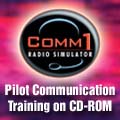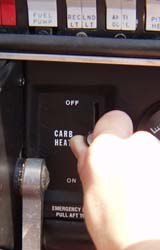| Advertisers
               
Do not reply to this e-mail. Got news? Contact ePilot. Having difficulty using this service? Visit the ePilot Frequently Asked Questions now at AOPA Online or write to [email protected].
Aircraft Owners and Pilots Association
421 Aviation Way
Frederick, MD 21701
Tel: 800/USA-AOPA or
301/695-2000
Copyright � 2002 AOPA. | Training Tips
| DEALING WITH CARB ICE
 A hot, humid August afternoon may seem an unlikely time for a discussion of the aeronautical hazards of ice. Not true. For pilots of airplanes with carbureted (non-fuel-injected) engines, summer conditions, especially combined with flight at low throttle settings, can be a recipe for carburetor ice formation. However, prudent use of carburetor heat, and alertness for any signs of icing (such as a gradual loss of engine rpm or manifold pressure), will keep problems at bay. A hot, humid August afternoon may seem an unlikely time for a discussion of the aeronautical hazards of ice. Not true. For pilots of airplanes with carbureted (non-fuel-injected) engines, summer conditions, especially combined with flight at low throttle settings, can be a recipe for carburetor ice formation. However, prudent use of carburetor heat, and alertness for any signs of icing (such as a gradual loss of engine rpm or manifold pressure), will keep problems at bay.
Understanding basic functions of an aircraft carburetor as explained in the January 1994 AOPA Pilot article, "How it Works: Carb Talk," will help you see how carb icing can occur on a hot day. The rapid drop in temperature of air passing through a carburetor is the key ingredient. A pilot should be especially vigilant for indications of carburetor ice whenever moisture is visible or humidity is high. Low throttle settings increase vulnerability, which is why many aircraft checklists require application of carb heat before power reductions are made. "Even a slight accumulation of this deposit will reduce power and may lead to complete engine failure, particularly when the throttle is partly or fully closed," notes the Pilot's Handbook of Aeronautical Knowledge. Click here to download it and read the comprehensive discussion of carb icing, and conditions conducive to it.
Obviously, awareness of carb icing is especially important in the training environment, in which much time is spent practicing low-throttle exercises such as flight at minimum controllable airspeed, landing approaches, and simulated engine failure emergencies. See how one new instructor's failure to add carburetor heat turned a simulated emergency into the real thing as recounted in the April 2002 AOPA Flight Training. Then consider how a more alert student/instructor duo recognized and coped with the onset of ice in cruise flight in the AOPA Pilot article "Iced Over the Apple."
Be sure that you don't let the cure become more of a hazard than the disease! Remember that one drawback of using carburetor heat as a preventive measure is that it robs the engine of power. That's because the heated air entering the carburetor is less dense than cooler air. It is critical, therefore, to verify that carb heat is off when adding throttle during normal takeoffs and go-arounds. See how failure to do so became a factor in an August 1989 trainer mishap as recounted in the August 2001 AOPA Flight Training. Keep alert to the possibility of carb icing, and be ready to deal with it promptly.
| Your Partner in Training
| Displaced threshold; empennage; VOR; pirep–what does it all mean? Aviation is an industry of acronyms and technical language. Especially helpful to newcomers to aviation is AOPA's Student Glossary for General Aviation. Log on to AOPA Online and if you need more information, call our experienced pilots–available toll-free at 800/872-2672 to answer your questions on weekdays between 8:30 a.m. and 6 p.m. Eastern.
As an AOPA Flight Training Member, you have access to all of the features within AOPA Online. For login information click here.
| Flight Training News
| EMBRY-RIDDLE WINS CONTRACT TO TRAIN AIR FORCE PILOTS
Embry-Riddle Aeronautical University has won a major contract from the U.S. Air Force Academy to provide introductory flight training to cadets and lieutenants who will become Air Force pilots. The $14.5 million, 5-year contract calls for a 50-hour flight-training program in Colorado Springs, Colorado, that results in private pilot certificates for up to 300 Air Force cadets in the first year and involve up to 540 students each of the remaining four years of the contract. "[Embry-Riddle] gave us the best value for our money," said Col. Brian Bishop, commander of the 34th Operations Group at the academy. "They are very well respected in aviation communities. We want to be a safe program, a quality program, and we know Embry-Riddle's going to be able to provide this for us." The university, which has ties with the U.S. military that go back to World War II, when it trained more than 25,000 aviators and technicians, will lease 35 Diamond DA20-C1 airplanes for the program. For more information, visit Embry-Riddle's Web site.
FAA TO STUDY FLIGHT SERVICE FUNCTIONS
The FAA announced that it is moving forward with a study that will compare the agency's cost of providing flight service station services to the cost of contracting services to commercial companies. Many student pilots obtain their weather briefings by telephone from flight service. The 18-month study will be conducted under the guidelines of the Office of Management and Budget Circular A-76, which directs government agencies to examine functions that might be performed by commercial sources. The study will look at alternatives for providing modernized flight services to pilots with the government still retaining the ultimate responsibility for providing the service. "All air traffic control services are critical to public safety and should be provided by the government without fees," said AOPA President Phil Boyer. "But our members certainly know there may be better ways of doing things. AOPA will keep a close watch on this study since, regardless of the outcome, it will point to how we can build a better FSS system capable of meeting pilots' needs in the twenty-first century." See AOPA�Online.
| Inside AOPA
| ONE WEEK LEFT IN TRINIDAD AUCTION
There's only a little over a week to place a bid on the EADS Socata TB20 Trinidad, offered as part of the AOPA Air Safety Foundation's Online Silent Auction. The foundation has received nearly 50 bids. The highest bid of $376,000 is still below the estimated value. The airplane features a one-of-a-kind patriotic paint scheme, a state-of-the-art instrument panel, and a lot of extras. Have a closer look on AOPA Online, then place your bid. Bidding closes on August 31 at 11 p.m. Eastern time.
AOPA'S BOYER HELPS OPEN OHIO AIRPORT
AOPA President Phil Boyer joined local dignitaries in Bellefontaine, Ohio, on August 16 for the grand opening of a brand-new $13 million municipal airport–only the second new airport in Ohio during the past 30 years. "This is a real community story of people sticking together to build a dream," Boyer told the large dedication crowd. "They clearly know and appreciate the value of local airports." In his remarks at the ceremony, Boyer noted that the number of public-use GA airports has been declining for many years, with nearly 25 percent fewer public-use airports today than in 1969. The new airport is four miles west of (and replaces) the old Bellefontaine Municipal Airport. It features a 5,000-foot runway, a new terminal building, and 10 new T-hangars, with 10 more under construction.
Changing your mailing or e-mail addresses? Click here to update.
| Training Products
| THINK WATER FLYING
Does landing on the water sound fun? It is if you're flying a seaplane. You can train in seaplanes to become a private pilot, or add on the seaplane rating later. Aviation Supplies and Academics is offering two new books on the subject, Seaplane Operations for $34.95 and Water Flying Concepts for $19.95. For more information or to order, call 800/426-8338 or visit the Web site.
| Final Exam
| Question: I learned that the two large numbers within each latitude/longitude "box" on a sectional chart are the minimum msl altitude required to clear terrain and towers within that chart section. But, where is this explained?
Answer: You are actually talking about the "maximum elevation figure" (MEF). The MEF represents the highest elevation, including terrain and other vertical obstacles, bounded by ticked lines of "graticule." Graticules on sectionals are the lines dividing each 30 minutes of latitude and each 30 minutes of longitude. MEF figures are depicted to the nearest 100-foot value msl (mean sea level). For example, 12,460 feet msl would be represented as a large 12 with a smaller 5. They are shown over land masses as well as over open water areas containing manmade obstacles such as oil rigs. A brief definition of MEF is shown on the margin of each sectional. The Aeronautical Chart User's Guide ( click here to download) gives a detailed explanation of the MEF, including how it is determined. For more information on the MEF, see AOPA Flight Training article "Flying Smart: Legends–Maximum Elevation Figure."
Got a technical question for AOPA specialists? E-mail to [email protected] or call 800/872-2672.
| Picture Perfect
| | Jump to the AOPA Online Gallery to see the featured airplane of the day. Click on the link for details on how to capture wallpaper for your work area. See AOPA Online.
| What's New At AOPA Online
| If you're not learning to fly at a nontowered airport, you're certain to visit one during your training. The AOPA Air Safety Foundation has updated its Operations at Nontowered Airports Safety Advisor. You may download the publication from AOPA Online.
| Weekend Weather
| See the current weather on AOPA�Online, provided by Meteorlogix.
| ePilot Calendar
| WEEKEND FLYING DESTINATIONS
Cleveland, Ohio. The Cleveland National Air Show takes place August 31 through September 2 at Burke Lakefront Airport (BKL). Featuring the Air Force Thunderbirds, Aeroshell Aerobatic Team, and much more. Contact Kim Dell, 216/781-0747 or visit the Web site.
For more airport details, see AOPA's Airport Directory Online . For more events, see Aviation Calendar of Events.
ASF FLIGHT INSTRUCTOR REFRESHER CLINICS
(All clinics start at 7:30 a.m.)
The next AOPA Air Safety Foundation Flight Instructor Refresher Clinics are scheduled in Long Beach, California; Newark, New Jersey; and Reston, Virginia, on August 24 and 25. Clinics are also scheduled in Sacramento, California; Colorado Springs, Colorado; and Des Moines, Iowa, on September 7 and 8. For the Flight Instructor Refresher Clinic schedule, see AOPA Online.
ASF PINCH-HITTER GROUND-SCHOOL COURSES
(Pinch-Hitter courses start at 9:30 a.m.)
The next Pinch-Hitter� Ground Schools will take place in Frederick, Maryland, September 7, and Colorado Springs, Colorado, September 8. For more Pinch-Hitter courses, see AOPA Online.
ASF SAFETY SEMINARS
AOPA Air Safety Foundation Safety Seminars are scheduled in Albuquerque, New Mexico and East Windsor, Connecticut, September 9; Warwick, Rhode Island, September 10; Tucson, Arizona and Billerica (Boston), September 11; and Mesa, Arizona, and Portsmouth, New Hampshire, September 12. The topic is Single-Pilot IFR. For the complete schedule, see AOPA�Online.
To make submissions to the calendar, visit AOPA Online. For comments on calendar items, e-mail [email protected].
| |